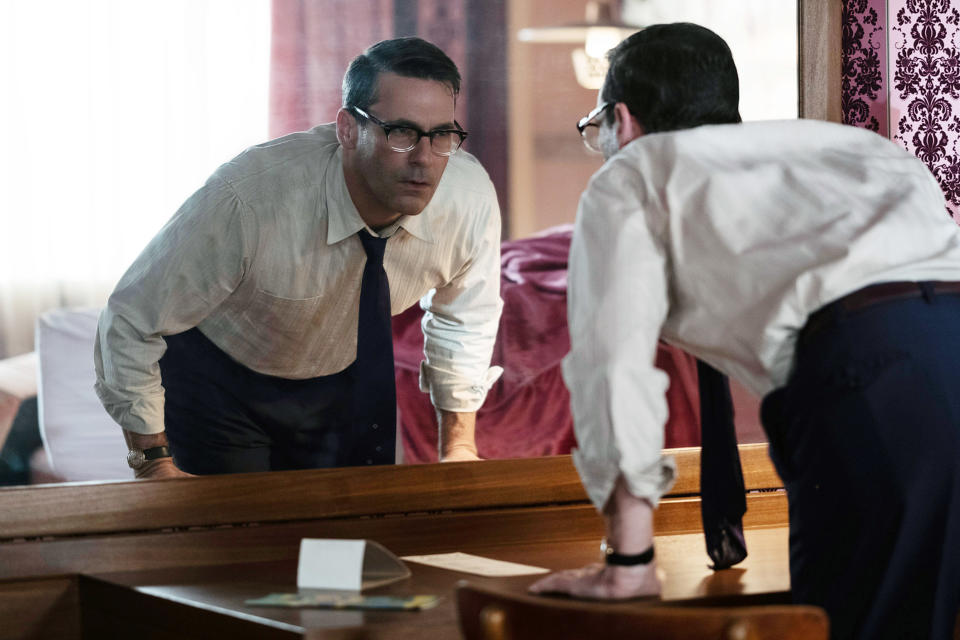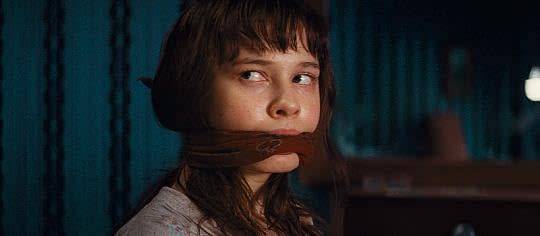Let the ‘Bad Times’ Roll — What Audiences Missed Out on by Not Seeing ‘Bad Times at the El Royale’

This October, in addition to the expected host of horror films and ritual “Over The Garden Wall” rewatches (you know who you are), there are some breakout performances on the horizon. Maybe the best cinematic reaction in “Lessons in Chemistry” (starting on Apple TV+ October 13) comes from Lewis Pullman, while Caelie Spaeny more than holds her own against Jacob Elordi’s Elvis in “Priscilla.” Pullman and Spaeny share a credit in common, in fact: a film celebrating its five-year anniversary on October 12 and one that, in many ways, created a blueprint for some of the most inventive storytelling we’ve seen in the years since.
“Bad Times at the El Royale,” written and directed by “The Martian” and “Cabin in the Woods” scribe Drew Goddard, received only mixed to positive reviews when it came out in 2018, and people mostly stayed away; it almost made back its $32 million budget, but the film neither broke even nor was a big enough box office dud to earn popular notice. Whatever oxygen the movie might’ve had in its home release/streaming afterlife seemed to be burned up the next year by “Once Upon a Time in Hollywood,” a movie with shirtless Brad Pitt instead of shirtless Chris Hemsworth, and a film that doesn’t take the same kind of structural leaps in order to violently break up a creepy hippie cult.
More from IndieWire
Which is a shame. “Bad Times at the El Royale” is a lot more than the violent finale and the loud structural reveals that complicate its “we’re all stuck in one spot” story. The film’s chapter/flashback structure that keeps its thriller/heist genre elements spinning are as noisy and colorful as a roulette wheel. But it’s what the characters do about it that’s so interesting.
A brief summary for the uninitiated: “Bad Times at the El Royale” follows a group of ne’er-do-wells (and Cynthia Erivo), who all find themselves stuck at the El Royale hotel one rainy night in the early ‘70s. The hotel’s seen much better days, as has Pullman, who plays the in-over-his-head concierge/bellhop/night manager, Miles. Noisiest among the guests is a G-man disguised as a racist vacuum salesman played by Jon Hamm; sketchiest is Jeff Bridges masquerading as a priest, Father Flynn, who is on the hunt for a score he and his brother (Nick Offerman) hid under the floorboards of one of the rooms a few decades ago; Erivo plays a singer, Darlene, in transit to another shitty gig. Dakota Johnson’s Emily, on the other hand, is forcibly transporting her sister Rose (Spaeny) away from the influence of the groovy, murder-y cult leader Billy (Chris Hemsworth).
Then the hotel itself is bigger on the inside, too: the rooms interconnected by a series of tunnels with “pervert windows” where nefarious Powers That Be could spy on/record prestigious guests in the El Royale’s heyday. Everyone’s competing agendas, suspicions, and secrets lead them down into the tunnels and the film to unfurl from a number of different “windows” of perspective. The struggle of Darlene, the protagonist among the ensemble, is honestly to come to grips with just how many other movies she’s in besides her own; then she has to juggle all of the other characters’ competing interests and generic baggage and assert her own narrative to survive the night.
One of the standout sequences of “Bad Times at the El Royale” is the scene of Darlene singing “Can’t Hurry Love” directly into a one-way mirror as Flynn crouches behind the bed with a crowbar and hammer. They need to rip up the floorboards to find the hidden cash, but they need to do it very quietly because anyone could be watching. Goddard begins the scene with a cut from Dakota Johnson getting up to figure out what happened to the other guests to Erivo seated in center frame, exactly the composition that we know is the point of view of the one-way mirror looking out onto her. She’s soaked, struggling to process all the murder she’s witnessed as she sings; it feels like a genuine moment of emotion, especially once she pauses the halting song to take off her wig.

It is and also it isn’t. Goddard and cinematographer Seamus McGarvey lean on slow camera movement to activate both the frame and our awareness that Darlene is doing more than just singing. The camera seems pulled to Erivo and the strength of her performance. It starts slowly circling her until it finally reveals Flynn’s hiding place. Both of them are putting on this performance for whoever might be watching. The next cut gives us another switch in perspective to Johnson in the spy tunnel, shotgun in hand.
The series of cuts that follow, between Darlene’s song, Emily watching and assessing the threat she might pose, and Flynn ripping up the floor in time to Darlene clapping, magnifies three lines of minute action and makes each of them feel breathlessly important. There’s tension through the coordinated timing of the clap and crowbar snap, naturally. Goddard is sure to sneak an insert shot of Emily’s hand on the gun to remind us that it’s there. But mostly, what makes the sequence — and the whole of “Bad Times at the El Royale” — work is the magic that happens in between each cut and perspective switch. The viewer is continually reminded that the whole story is more complex than any of its parts; there’s something thrilling about watching the way the entire puzzle fits together (the overhead shots of the sequence are the ones that maybe highlight the brilliant color balance of Martin Whist’s production design). Yet there’s also something poignant to the fact that not grasping the whole story keeps getting characters killed.
In other words, Erivo’s character has to do what we do, constantly. We need to make some kind of sense of the many worlds we’re in, whether we want to be or not.

2018 was not 2008, and the idea of a multiverse was not a foreign one to mainstream Hollywood when “Bad Times at the El Royale” premiered. Formal play with perspective switching is much, much older — and if you’re tired of all the Hitchcock examples from the ‘50s and ‘60s, it’s even present in a more benign way in 1955’s “It’s Always Fair Weather,” which musically hops between three characters mental anxieties/daydreams at a boring dinner. The creation of multiple, varyingly performative levels within the universe of a story is even older than 1924’s “Sherlock Jr.” but Buster Keaton has fun in that one so it’s worth citing. What “Bad Times at the El Royale” does is structure its story so that both the audience and the protagonist need to figure out what the movie is in order to succeed, and this is a pattern of narrative conflict that’s become increasingly more prevalent in the years since.
“Everything Everywhere All At Once” is perhaps the readiest example at hand, but “Barbie” and the “Spider-Verse” films all build on this idea. Evelyn (Michelle Yeoh) is in so many different movies in the Daniels’ film, from a Kar-Wai Wong romance to “Raccacoonie,” and her only prayer to save both herself and her family is to find some meaning in the howling chaos of all these absurdly clashing genre tropes and narratives pulling to define her millions of different ways. Barbie (Margot Robbie) has expectations for her existence that are upended by her quest to get to real world, which itself keeps getting morphed and changed and challenged (stupid patriarchy!) until she finally opts out of the Mattel Cinematic Universe in order to be a real person. In “Spider-Man: Across The Spider-Verse,” Miles Morales (Shameik Moore) is presented with the notion of The Canon itself, and his only prayer at saving all Spider-Verses is rejecting the way his stories always go. All these heroes’ ultimate conflict hinges on them understanding and then rewriting the terms of the movie that they’re in.
Part of what’s so fun about “Bad Times at the El Royale” is it applies this principle not just to its lead character but to every character. Pullman’s Miles the bellhop is pretty pathetic, pretty high, and then pretty full of buckshot for most of the movie. At two hours in, right as Bridges and Hemsworth are wrestling on the floor and overturning firepits and the gleeful strings on the Michael Giacchino score swing an octave lower, we get the title card that shifts perspective to Miles. In an economical flashback, Goddard strings together three short moments, only a handful of shots about 15 seconds each; through matches in sound and composition, we see Miles pulled from a little kid to sharpshooter to lone survivor of a battle in the Vietnam jungle; Goddard then spends the bulk of his time in Miles’ backstory in the quiet aftermath, reinforcing his crisis of faith.
It’s almost like the film gets a power-up every time Goddard does these point-of-view shifts: not only does he bring in the generic conventions of a different story, but the featured character becomes the active driver of events, temporarily asserting control over the narrative. The tragedy of Cailee Spaeny’s Rose, in many ways, is that the more we learn about her, the less it changes our understanding of her, her attraction to her cult idol, and the unaccountable violence she’ll use to protect him. Her segment of the film and Billy Lee’s are interchangeable in the way Goddard composes off-balance, threatening, but oddly beautiful frames.

“Bad Times at the El Royale” engages with the problem of audience awareness of story and genre tropes in a way that’s much more substantive than simply pointing them out to prove how clever the filmmakers are. Its approach to character growth through an awareness of story is one that’s been taken up again and again in the years since. If anything seems like a way forward out of IP smorgasbords drowning under the weight of their own lore, it is this kind of playful, efficient filmmaking that melds formal cleverness with character empathy.
Even if that wasn’t true, Pullman, Spaeny, Erivo and the rest of the “Bad Times at the El Royale” cast don’t miss a note. Films that pull off a contained, clever one-and-done thriller ought to be celebrated before they all close down.
“Bad Times at the El Royale” is streaming on Prime Video.
Best of IndieWire
Where to Watch This Week's New Movies, from 'Anatomy of a Fall' to 'Taylor Swift: The Eras Tour'
The Best Thrillers Streaming on Netflix in October, from 'Fair Play' to 'Emily the Criminal'
Sign up for Indiewire's Newsletter. For the latest news, follow us on Facebook, Twitter, and Instagram.

 Yahoo News
Yahoo News 
